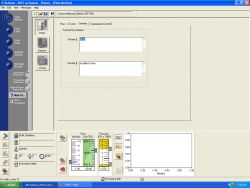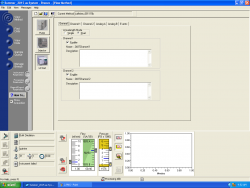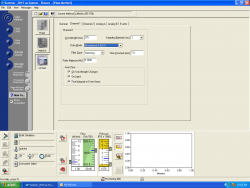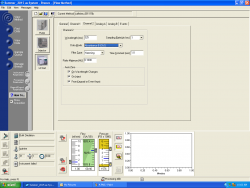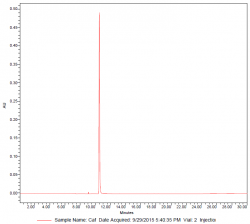Difference between revisions of "Caffeine HPLC Method"
Jump to navigation
Jump to search
| (15 intermediate revisions by 2 users not shown) | |||
| Line 1: | Line 1: | ||
| − | + | Caffeine can be detected using Reversed Phase High Pressure Liquid Chromatography with UV Detection. (Chris Knutson, 2015) | |
| − | + | In order to accomplish caffeine analysis the HPLC system requires the following: | |
| − | {| | + | *C18 column |
| + | *UV Detector Monitoring 275nm | ||
| + | *Mobile Phase | ||
| + | **Acetonitrile | ||
| + | **0.1% Acidified Water | ||
| + | |||
| + | Samples should be filtered through 45 μm syringe filters into HPLC sample vials, capped, labeled, and loaded into the HPLC auto-sampler carousel. | ||
| + | |||
| + | |||
| + | |||
| + | =High Pressure Liquid Chromatography Setup (HPLC)= | ||
| + | |||
| + | |||
| + | ==Pump Gradient== | ||
| + | |||
| + | {| class="wikitable" | ||
| + | || | ||
| + | ||Time | ||
| + | ||Flow | ||
| + | ||%A | ||
| + | ||%B | ||
| + | ||Curve | ||
| + | |- | ||
| + | ||1 | ||
| + | || | ||
| + | ||1.00 | ||
| + | ||0.0 | ||
| + | ||100.0 | ||
| + | || | ||
| + | |- | ||
| + | ||2 | ||
| + | ||3.00 | ||
| + | ||1.00 | ||
| + | ||0.0 | ||
| + | ||100.0 | ||
| + | ||6 | ||
| + | |- | ||
| + | ||3 | ||
| + | ||15.00 | ||
| + | ||1.00 | ||
| + | ||60.0 | ||
| + | ||40.0 | ||
| + | ||6 | ||
| + | |- | ||
| + | ||4 | ||
| + | ||20.00 | ||
| + | ||1.00 | ||
| + | ||60.0 | ||
| + | ||40.0 | ||
| + | ||6 | ||
| + | |- | ||
| + | ||5 | ||
| + | ||25.00 | ||
| + | ||1.00 | ||
| + | ||0.0 | ||
| + | ||100.0 | ||
| + | ||6 | ||
| + | |} | ||
| + | |||
| + | ==Solvents== | ||
| + | *Solvent A: Acetonitrile | ||
| + | *Solvent B: 0.01% Acidified Water | ||
| + | |||
| + | ==UV Detection== | ||
| + | *Dual Wavelength Detection | ||
| + | *Channel 1: 275nm | ||
| + | *Channel 2: 325nm | ||
| + | |||
| + | |||
| + | |||
| + | {| | ||
||[[File:1.PNG|thumb|250px|frame|center|HPLC Pump Gradient Flow Settings]] | ||[[File:1.PNG|thumb|250px|frame|center|HPLC Pump Gradient Flow Settings]] | ||
||[[File:2.PNG|thumb|250px|frame|center|HPLC Pump Solvent Settings]] | ||[[File:2.PNG|thumb|250px|frame|center|HPLC Pump Solvent Settings]] | ||
| Line 13: | Line 83: | ||
|} | |} | ||
| + | =Trial Configuration= | ||
| + | The samples can be injected in 10 μl increments and trials can range in length from 15-30 minutes depending upon the complexity of one's sample. | ||
=Results= | =Results= | ||
| − | Caffeine should be detected as sharp peaks at 275nm | + | Caffeine should be detected as sharp peaks which elute at approximately 11 minutes when monitoring 275nm on the UV Detector. |
| − | [[File:Std.PNG|thumb|250px|frame| | + | |
| + | The image below is the spectra of a caffeine standard run with the above method. | ||
| + | [[File:Std.PNG|thumb|250px|frame|left|Caffeine Standard Spectra]] | ||
Latest revision as of 13:04, 6 October 2016
Caffeine can be detected using Reversed Phase High Pressure Liquid Chromatography with UV Detection. (Chris Knutson, 2015)
In order to accomplish caffeine analysis the HPLC system requires the following:
- C18 column
- UV Detector Monitoring 275nm
- Mobile Phase
- Acetonitrile
- 0.1% Acidified Water
Samples should be filtered through 45 μm syringe filters into HPLC sample vials, capped, labeled, and loaded into the HPLC auto-sampler carousel.
High Pressure Liquid Chromatography Setup (HPLC)
Pump Gradient
| Time | Flow | %A | %B | Curve | |
| 1 | 1.00 | 0.0 | 100.0 | ||
| 2 | 3.00 | 1.00 | 0.0 | 100.0 | 6 |
| 3 | 15.00 | 1.00 | 60.0 | 40.0 | 6 |
| 4 | 20.00 | 1.00 | 60.0 | 40.0 | 6 |
| 5 | 25.00 | 1.00 | 0.0 | 100.0 | 6 |
Solvents
- Solvent A: Acetonitrile
- Solvent B: 0.01% Acidified Water
UV Detection
- Dual Wavelength Detection
- Channel 1: 275nm
- Channel 2: 325nm
Trial Configuration
The samples can be injected in 10 μl increments and trials can range in length from 15-30 minutes depending upon the complexity of one's sample.
Results
Caffeine should be detected as sharp peaks which elute at approximately 11 minutes when monitoring 275nm on the UV Detector.
The image below is the spectra of a caffeine standard run with the above method.

